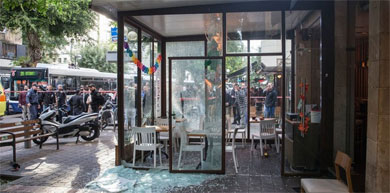Guerrilla Art Exhibit Unmasks the Face of Terrorism
By Peter Baker
Sept. 6, 2016

The site of an attack in Tel Aviv on Jan. 1. On Monday, a guerrilla art exhibition projected scenes from the attack on giant screens over Dizengoff Square, near where the shootings took place. Credit Jack Guez/Agence France-Presse — Getty Images
Eight months after the attack, the killer’s face hovered over Dizengoff Street again, full of menace and malevolence.
On a giant outdoor screen, the killer, Nashat Melhem, talked about death and cursed the Jews as evening strollers passed by, a chilling voice from beyond the grave that was taped on his mobile phone before he opened fire on the crowds gathered here on New Year’s Day.
His video presence was part of a guerrilla art exhibition unveiled in Tel Aviv on Monday night, an installation meant to capture the faces of terrorism in a country hardened to the sort of violence now shocking Europe and America. The exhibition featured three adjoining videos projected on a billboard, the first showing Mr. Melhem, the second showing security forces responding to his attack, and the third showing the bar he shot up, portrayed full of life again, as if nothing had happened.
Secretary of State John Kerry suggested recently that less attention should be paid to terrorism in order to keep it in perspective. But Ronny Douek, the philanthropist and social activist who sponsored the video display, wants Israel, and by extension the world, to stare it in the face. Only by confronting terrorism, he said, can society address it.
“A lot of people don’t want to stop and speak,” Mr. Douek said on Monday as pedestrians looked up at the screens and then moved on.
“That’s the story of this country: You want to go forward,” he said. “I’m trying to do something that depicts the environment we live in here. This is something you see happening around the world now.”
It was the juxtaposition of the images that transfixed Mr. Douek and inspired him to organize the display, which he initiated over the bustling Dizengoff Square, just a few blocks down Dizengoff Street from where the shooting occurred. He decided to show, in a series of adjacent images, the depravity of the attacker, the chaos he created and the world moving on — different phases of a grim modern reality.
Mr. Douek, a businessman who was a founder of the social change movement Zionism 2000 and of other civic organizations, said Israel needed to show more respect to its Arab citizens to help prevent the sort of alienation that gives rise to violence. “People think you can deal with terrorism just by killing people,” he said. “It doesn’t work that way.”
The attack on display in the exhibit occurred on Jan. 1, when Mr. Melhem, an Arab citizen of Israel, shot up a pub, a cafe and a sushi restaurant in the middle of the afternoon. Alon Bakal, the manager of the pub, Simta, and Shimon Ruimi, a customer, were killed. Mr. Melhem fled by taxi and later killed the cabdriver, Amin Shaban, also an Arab Israeli. Mr. Melhem died in a shootout with the authorities about a week later.
On the video found on his cellphone, Mr. Melhem rambled incoherently, saying he had been drinking beer and smoking hashish. He cursed “Obama the crusader” and said, “I am going up to our lord, the Prophet Muhammad.” He suggested he was taking action “so the Jews understand who they’ve been involved with, those sons of bitches.”
His attack came during a wave of stabbings and vehicle assaults, mainly by Palestinians, that rattled Israel, which occupies the West Bank. The attacks seemed uncoordinated and very few were conducted by Arab citizens of Israel. Although the Israeli authorities said Mr. Melhem may have been inspired by the Islamic State, they noted that his erratic, drug-fuelled behaviour was contrary to Islamic rules and suggested that he was working alone.
Tania and Elie Suares were out for a walk Monday evening when they saw the video displays and stopped to watch for a few moments. They vividly recalled the day of the attack.
“We were very close when that happened,” said Ms. Suares, 46, a tutor of English. “We actually heard the gunfire in our apartment. Our daughter walked by right before it happened. It was pretty chilling to know it happened right where she was.”
But, she said, “people the very next day go back to living, actually living, not just acting that way. Sadly, it’s the reality of what’s been going on here forever. It’s like a coping mechanism.”
Erez Davidi, 31, a business owner, said he was only 30 to 35 feet from the gunman during the rampage. “I turned around and I saw him standing and shooting,” he recalled Monday night as he stared up at the video display. “He was just shooting all over the place.”
Still, Mr. Davidi was not convinced that the art exhibition — which Mr. Douek hopes will run for a few days — would have much impact. “I don’t think there will be any benefits of watching it again,” he said. “It’s too common. It happens too much. Everybody forgot about it two days after.”
Ram Landes, a television producer and a friend of Mr. Douek’s, said that the attitude described by Mr. Davidi was familiar. “Denial,” he said, “is the main ability the Israelis develop.”
Source: nytimes.com/2016/09/07/world/middleeast/tel-aviv-dizengoff-art-terrorism.html?emc=edit_tnt_20160906&nlid=71783194&tntemail0=y




 Moderate Islamist here
Moderate Islamist here


0 comments:
Post a Comment